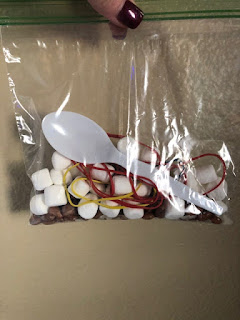A new semester has begun for me, and this will be my second semester of teaching an Elementary Science Methods course to pre-service teachers remotely. Teaching hands on science remotely seems like quite a paradox, but I've learned that it doesn't have to be!
My philosophy of teaching science is a constructivist approach, which means I have a strong belief that people (students and adults) learn science concepts best if they get to experience science though hands on experiences. One strategy I have always used in my science methods class is to have my university students take on the role of elementary students and engage in activities and experiments in class. With the remote class I've had to think a little outside the box.
One strategy I am currently using is to make take home science kits for students. I began by brainstorming experiments and activities that could be done with easy to access and inexpensive materials I also wanted the experiments to cover a wide range of science topics to give my students experiences in all areas of science. The kits I created include a battery, a piece of insulated wire with the ends stripped, a mini lightbulb, a pipette, 10 sugar cubes, a film canister, 2 Alka Seltzer tablets, a snack bag containing rice, mini marshmallows, beans, and rubber bands, plastic tweezers, a toothpick and a plastic spoon, a magnet and a piece of foil. These simple materials will allow my students to engage in 6 different science activities or experiments. They easily fit in a gallon sized Ziploc bag, and students can come to campus to pick them up.
Experiment 1: Let Their Be Light
Students are tasked with trying to light a lightbulb using a wire, a bulb, and a battery. No directions are given so that students can experiment. They then make simple sketches of ways that worked, and ways that did not. The drawings can serve as a great starting point for discussion. Simply asking, "What do you notice about the ones that did work?" can get students to understand what a complete circuit is.
Experiment 2: Weathering Activity
Students build mini houses using their sugar cubes. They are then directed to "rain" lightly on their homes using a pipette and a small cup of water. Although our homes don't dissolve with rain, this activity shows the power of water on softer rocks such as sandstone.
Experiment 3: Film Canister Rockets
This activity involves the chemical reaction of Alka Seltzer tablets in water. The gases build up inside the film canister and force the cap to fly off. The idea of Newton's 3rd law that states for every action there is an opposite and equal reaction is demonstrated. This activity does require safety reminders and can be conducted in two ways. Students can put water in the film canister and then add the Alka Seltzer and quickly put the cap on and turn the canister cap side down. Or, a safer option is to place the canister on it's side so that it launches across the floor instead of straight up. Time in flight can be used to measure option 1, and distance can be used to measure option 2. Students can be challenged to change the amount of water and/or the amount of Alka Seltzer for the best launch.
Experiment 4: Birds and Beaks
For this activity students investigate different beaks and discover which kind of food is more suitable for different beaks. Students spread out the materials in the sandwich bag (beans, mini marshmallows, rubber bands, and rice) They then "eat" using different types of beaks (spoon, tweezers, toothpick) for 30 seconds. The rule is they can only pick up one piece of food at a time using the beak in the way it was intended. They can put the "food" into a cup. I make a google sheet for students to record how many of each type of food they eat and then students look for patterns and discuss what they notice.
For experiment 5 I included a magnet to allow student to do some investigating with magnets. I also included a piece of foil for experiment 6 to allow students to investigate the engineering design process to see how many pennies a foil boat they construct can hold.
I have the students conduct some of the experiments with me over Zoom, and for some experiments I used videos in apps like Nearpod and EdPuzzle to have students work through the experiments with me asynchronously. Feedback I've received from last semester indicates that students really appreciate getting to experience science through hands on opportunities, so I think me extra effort is well worth it.
Do you have some simple science activity ideas that might work well for take home science? Share your ideas in the comments below.










